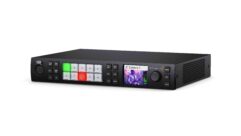Sound System Design Essentials ? Part 1
In room modeling, a solid plan is a good start to ensure getting the most from your audio.
The arc numbering convention for loudspeaker balloon measurements. The numbers with V prefixes identify the arc. The numbers with H prefixes identify the position along the arc.
ROOM modeling programs can assist in determining key performance attributes of a sound system at the drawing board stage of a project. Most contractors and consultants know they should use one.
This is the first of a series that will describe important, universal concepts regarding room modeling. As with most things audio, if your room modeling is guided by intuition alone, you will usually get the wrong answer.
Intuition is an invaluable tool, but only when guided by the proper underlying physics.
The first step to effective use of any of these programs is to understand the data, which breaks down into two categories: loudspeaker data and room data. In this article, we’ll focus on loudspeaker data.
You can find useful diagrams for visualization at www.etcinc.us/data.htm (scroll to the bottom of the page). Also visit www.clfgroup.org and download the free data viewer and some sample data. I will use the common loudspeaker format (CLF) for my examples, but the principles apply to any data format.
Axial Sensitivity
Designers have long used the measured on-axis sensitivity of the loudspeaker as a design metric. This is the on-axis frequency response of the loudspeaker measured with a known input signal (i.e. 1 watt) at a known distance (i.e. 1 meter). For point source-type loudspeakers, this response can be extrapolated to any greater distance using the inverse-square law, and scaled to any level by increasing the drive level from that used for the specification (typically about 3Vrms, which is 1 watt into 8 ohms). Of course, most listeners are not on-axis, so you must use polar measurements to determine the response at other angles. You make these by repeating the measurement at different angles around the loudspeaker. These angle-dependent levels usually are graphed relative to the on-axis level to form a polar plot. To understand how modeling programs work, it is important to understand polar data and its sibling, balloon data.
Navigation Basics
The horizontal and vertical polars represent two “slices” through an imaginary sphere around the loudspeaker. Of course, a sphere is round, and when you measure on a sphere, you have to keep track of where you are. The Earth is round, and people have developed clever methods for determining their positions on it. Most are familiar with the lines of longitude and latitude from elementary school. This system can be used to determine the measurement positions around a loudspeaker.
Looking at the globe, the lines of longitude are all the same length, running from pole to pole. They are also called arcs or meridians. I prefer arc when referring to loudspeaker measurements.
The lines of latitude are spaced equally and circle the globe at right angles to the lines of longitude. The most famous of these is the equator, which is equal distance from the north and south poles. The lines of longitude and latitude intersect, forming a grid and a coordinate system for determining a location on the sphere.
Let’s use this grid system to determine the test positions around a loudspeaker. The proper mental image is imperative. Imagine the loudspeaker at the center of the sphere, on its back and facing the North Pole. Next, rotate the entire sphere (including the loudspeaker) by 90 degrees so that it points straight at the listener. The arcs now run from directly in front of the loudspeaker to directly behind it.
When a loudspeaker is measured, the microphone starts in front (the axial position) and moves along one of the arcs until it is behind the loudspeaker. In practice, the microphone usually is stationary and the loudspeaker is moved, which produces the same result. The angular resolution typically ranges from 15 degrees at a minimum to 1 degree at a maximum. The positions along the arc are labeled with integer angles preceded by an “H,” so on-axis for any arc is always H000. H090 is straight out to the side of the loudspeaker, and H180 is always directly behind it. Remember, this is true for any arc around the loudspeaker. Using H as an identifier is a bit confusing, because it is natural to assume that it stands for horizontal. But only two of the arcs around the loudspeaker actually make up the horizontal polar.
Once an arc is measured, the loudspeaker is rotated about its aiming axis by an angle equal to that used along the arc. Another arc is measured, starting at H000 and finishing at H180. Of course, it is necessary to distinguish this arc from the one previously measured. A common method is to precede the angle with a “V.” This gives each measurement the form VxxxHxxx where xxx are the angle numbers (i.e. 0, 10, 20, 30… for 10-degree resolution). Hxxx is the position on the arc, and Vxxx is the arc number.
This coordinate system is sufficient to describe any position around the loudspeaker. The key arcs are the horizontal and vertical polars. One-half of the horizontal polar will be from V000H000 to V000H180, with the H component incrementing at the desired angular resolution. The other half will be from V180H000 to V180H180. The V component stays the same as the horizontal increments.
One-half of the vertical polar will be V090H000 to V090H180, and the other half will be from V270H000 to V270H180.
Of course, the other arcs around the loudspeaker can also be measured. All one needs to do is to keep measuring arcs, while incrementing the Vxxx for each new arc. The key to understanding this is to remember that what is always measured is an arc from front to back, and this arc can be measured at any rotation of the loudspeaker about its aiming axis. The V and H designations refer to the orientation of the turntable used to rotate the loudspeaker. The H turntable is parallel to the floor, and the V turntable is perpendicular to it.
Pat Brown is president of Synergetic Audio Concepts (Syn-Aud-Con) Inc. and Electro-Acoustic Testing Company (ETC) Inc. Syn-Aud-Con conducts training seminars worldwide in audio and acoustics for those who operate, design and install sound reinforcement systems. ETC performs precision loudspeaker tests for the audio industry. Pat can be reached at [email protected].










